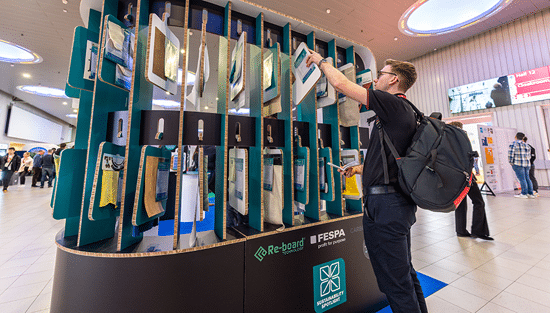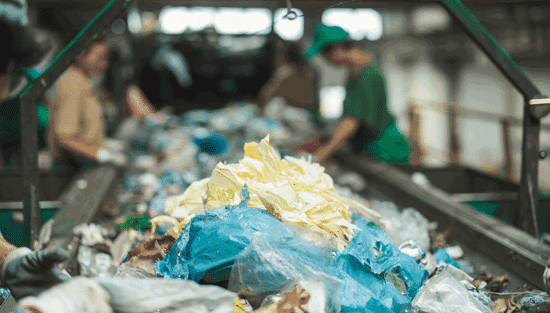A beginner’s guide to regenerative capitalism

To address the world’s biggest challenges we need a radical new approach to economics – could regenerative capitalism be the answer?
The evidence is clear – the climate is changing for the worse. Scientists now widely agree that we are part of a new age of life, the Anthropocene – a geological epoch that began when humankind first started to have a significant impact on the Earth’s ecosystem. Researchers argue this epoch began in 1950.
With COP26 (the United Nations Climate Change Conference in Glasgow) fast approaching, the climate conversation is taking on a new urgency, one that has gradually – and then rapidly – made its way down from climate scientists to the everyday consumer. And that’s across the board. FESPA’s 2018 Print Census, for example, shows that 76% of printers say that customer demand for environmentally-responsible products is shaping business strategy, with more than one in five stating that it’s a major influence.
The world is in a sinkhole it cannot climb out of under the current deregulated capitalist structure
But it’s increasingly apparent that a tick-box approach to the climate crisis is not going to be enough to mitigate its worst impacts. Our entire global operations need a radical overhaul, and this is where the idea of regenerative capitalism comes in.
Not such a free market
An idea floated by disillusioned Wall Street banker John Fullerton in 2015, regenerative capitalism is an economic system that recognises that the market we have now is not – as traditional economists might claim – a wonderfully self-correcting free market, but rather one that is manipulated by powerful forces that demand the goods and services we take from one another, and the value we extract from natural resources, come with a cost.
This cost – in pursuit of the age-old “more is better” principle – has led to a perfect storm of inequality, poverty and environmental devastation. It is a sinkhole the world cannot climb out of under the current deregulated capitalist structure.
Regenerative capitalism, by contrast, draws from a single core idea, that the universal patterns and principles the cosmos uses to build stable, healthy, and sustainable systems throughout the real world can and must be used as a model for economic-system design.
In his comprehensive report, Regenerative Capitalism: How Universal Principles And Patterns Will Shape Our New Economy, Fullerton himself acknowledges that this sort of holistic thinking is sometimes viewed as “the province of mystics or hippies”, but notes that increasing fields of science are using this approach to support explanations of how universal dynamics, such as energy and pressure, “shape health and development in real-world systems of all kinds”.
Additionally, he notes, regenerative economics is not about the “well-worn debate” of capitalism verses socialism. “Both systems, even if flawlessly executed, are unsustainable,” he says.
Into the doughnut
Instead, regenerative capitalism differs from most current approaches to sustainability in that, instead of focusing on social and environmental health using traditional reductionist logic to “solve problems”, it aims directly at building healthy human networks as the objective. It draws on universal principles and patterns, with “sustainability” as an outcome – a natural by-product – of systemic health. In other words, sustainability is the result, not the design principle, and the environment is an equal player, not just a passive resource.
This, proponents argue, is what differentiates regenerative capitalism from other models of sustainability. The circular economy principle, for example, encourages us to move away from the traditional capitalist notion of “take, make, waste”, but is limited. Materials can only be recycled or reused so many times, and while our “debt” to nature doesn’t increase, it doesn’t reduce either. We need to take action to improve the present level of natural resources.
Industry must “integrate elements of head, heart, and hands – the three key factors that move human beings”
Similarly, Kate Raworth’s theory of “doughnut economics” faces the same challenges. Raworth proposes a doughnut-shaped model of two concentric rings: a social foundation that ensures no one falls short on life’s essentials, such as food, healthcare, education and social equity, and an ecological ceiling that ensures humanity doesn’t overshoot planetary boundaries of pollution, land and water loss, and ozone layer depletion. Between these two boundaries lies a doughnut-shaped space that is both ecologically safe and socially just – a space in which humanity can thrive. However, critics suggest it doesn’t adequately address the previously mentioned sinkhole, or how the world can climb out of it before it can tangibly adopts the principles of this model.
But this isn’t to say these models are without merit. As Fullerton says in his report: “We must urgently focus on efficiency gains to buy time.” Circularity and doughnut economics are good places to start. “But at the same time, we must also look ahead and envision a truly regenerative system design. That is something entirely new, requiring fresh imagination, not just incremental tweaking around the edges.”
Considering the impacts
The key question is: how can we make the transition to regenerative capitalism? More specifically, what can printers do, inherently reliant as they are on materials, processes and resources?
According to Fullerton, industry must “integrate elements of head, heart, and hands – the three key factors that move human beings.” These translate into: understanding what makes human networks healthy; a unifying, noble purpose that inspires people to serve a cause greater than themselves; and the ability to turn noble ideas and purpose into effective practical action.
Printers should examine the entirety of their operations for dead spots where a more active, regenerative approach could be adopted
For printers, a traditional economic approach might view the printing process separately from the material extraction, resource consumption and workers on which it relies. It might also not consider the impact print manufacturing has on the environment, politics or economics of an area.
Regenerative capitalism, however, views the entire chain of cause and effect that leads to, and away from, printing, and instead of focusing on finding a single “right” answer – as so much sustainability narrative dictates – instead focuses on finding balanced answers that address seemingly contradictory goals, such as collaboration and competition, and efficiency and resilience.
According to Fullerton, this is already happening incrementally, with an increasing number of companies responding to the regulatory and reputational pressure that is helping to change agriculture, forestry and mining and embed holistic principles throughout industry. Printers can do the same by examining the entirety of their operations – from materials and suppliers to transport and logistics – for dead spots where a more active, regenerative approach could be adopted.
Radically better?
John Elkington, the business author and sustainability commentator behind the oft-touted “triple-bottom line” model, believes there’s a “green swan” on the global horizon, a “profound market shift” catalysed by changing paradigms, values, mindsets, politics, policies, technologies, business models and other key factors. It represents exponential progress in the form of economic, social and environmental wealth creation, and as he says in his book Green Swans: The Coming Boom In Regenerative Capitalism, “getting from here to there will be no trivial task,” but it nonetheless has the potential to represent “radically better times to come”.
Become a FESPA member to continue reading
To read more and access exclusive content on the Club FESPA portal, please contact your Local Association. If you are not a current member, please enquire here. If there is no FESPA Association in your country, you can join FESPA Direct. Once you become a FESPA member, you can gain access to the Club FESPA Portal.
Topics
Recent news

New sustainable materials at Sustainability Spotlight
Sustainability Spotlight returned by popular demand to FESPA Global Print Expo last month in an exhibit curated by The Good Factory.

Sportswear Pro: building ‘Brand Me’
After the success of the inaugural Sportswear Pro last month, we spoke with panellist and personalisation expert James Lawrence-Jones about the most exciting revelations at the event.

